
- 阻害剤
- 研究分野別
- PI3K/Akt/mTOR
- Epigenetics
- Methylation
- Immunology & Inflammation
- Protein Tyrosine Kinase
- Angiogenesis
- Apoptosis
- Autophagy
- ER stress & UPR
- JAK/STAT
- MAPK
- Cytoskeletal Signaling
- Cell Cycle
- TGF-beta/Smad
- 化合物ライブラリー
- Popular Compound Libraries
- Customize Library
- Clinical and FDA-approved Related
- Bioactive Compound Libraries
- Inhibitor Related
- Natural Product Related
- Metabolism Related
- Cell Death Related
- By Signaling Pathway
- By Disease
- Anti-infection and Antiviral Related
- Neuronal and Immunology Related
- Fragment and Covalent Related
- FDA-approved Drug Library
- FDA-approved & Passed Phase I Drug Library
- Preclinical/Clinical Compound Library
- Bioactive Compound Library-I
- Bioactive Compound Library-II
- Kinase Inhibitor Library
- Express-Pick Library
- Natural Product Library
- Human Endogenous Metabolite Compound Library
- Alkaloid Compound LibraryNew
- Angiogenesis Related compound Library
- Anti-Aging Compound Library
- Anti-alzheimer Disease Compound Library
- Antibiotics compound Library
- Anti-cancer Compound Library
- Anti-cancer Compound Library-Ⅱ
- Anti-cancer Metabolism Compound Library
- Anti-Cardiovascular Disease Compound Library
- Anti-diabetic Compound Library
- Anti-infection Compound Library
- Antioxidant Compound Library
- Anti-parasitic Compound Library
- Antiviral Compound Library
- Apoptosis Compound Library
- Autophagy Compound Library
- Calcium Channel Blocker LibraryNew
- Cambridge Cancer Compound Library
- Carbohydrate Metabolism Compound LibraryNew
- Cell Cycle compound library
- CNS-Penetrant Compound Library
- Covalent Inhibitor Library
- Cytokine Inhibitor LibraryNew
- Cytoskeletal Signaling Pathway Compound Library
- DNA Damage/DNA Repair compound Library
- Drug-like Compound Library
- Endoplasmic Reticulum Stress Compound Library
- Epigenetics Compound Library
- Exosome Secretion Related Compound LibraryNew
- FDA-approved Anticancer Drug LibraryNew
- Ferroptosis Compound Library
- Flavonoid Compound Library
- Fragment Library
- Glutamine Metabolism Compound Library
- Glycolysis Compound Library
- GPCR Compound Library
- Gut Microbial Metabolite Library
- HIF-1 Signaling Pathway Compound Library
- Highly Selective Inhibitor Library
- Histone modification compound library
- HTS Library for Drug Discovery
- Human Hormone Related Compound LibraryNew
- Human Transcription Factor Compound LibraryNew
- Immunology/Inflammation Compound Library
- Inhibitor Library
- Ion Channel Ligand Library
- JAK/STAT compound library
- Lipid Metabolism Compound LibraryNew
- Macrocyclic Compound Library
- MAPK Inhibitor Library
- Medicine Food Homology Compound Library
- Metabolism Compound Library
- Methylation Compound Library
- Mouse Metabolite Compound LibraryNew
- Natural Organic Compound Library
- Neuronal Signaling Compound Library
- NF-κB Signaling Compound Library
- Nucleoside Analogue Library
- Obesity Compound Library
- Oxidative Stress Compound LibraryNew
- Phenotypic Screening Library
- PI3K/Akt Inhibitor Library
- Protease Inhibitor Library
- Protein-protein Interaction Inhibitor Library
- Pyroptosis Compound Library
- Small Molecule Immuno-Oncology Compound Library
- Mitochondria-Targeted Compound LibraryNew
- Stem Cell Differentiation Compound LibraryNew
- Stem Cell Signaling Compound Library
- Natural Phenol Compound LibraryNew
- Natural Terpenoid Compound LibraryNew
- TGF-beta/Smad compound library
- Traditional Chinese Medicine Library
- Tyrosine Kinase Inhibitor Library
- Ubiquitination Compound Library
-
Cherry Picking
You can personalize your library with chemicals from within Selleck's inventory. Build the right library for your research endeavors by choosing from compounds in all of our available libraries.
Please contact us at info@selleck.co.jp to customize your library.
You could select:
- 抗体
- 新製品
- お問い合わせ
VEGFR
VEGFR製品
- All (118)
- VEGFR阻害剤 (102)
- VEGFR抗体(11)
- 新製品
| 製品コード | 製品名称 | 製品説明 | 文献中Selleckの製品使用例 | お客様のフィードバック |
|---|---|---|---|---|
| S7397 | Sorafenib (BAY 43-9006) | Sorafenib is a multikinase inhibitor of Raf-1 and B-Raf with IC50 of 6 nM and 22 nM in cell-free assays, respectively. Sorafenib inhibits VEGFR-2, VEGFR-3, PDGFR-β, Flt-3 and c-KIT with IC50 of 90 nM, 20 nM, 57 nM, 59 nM and 68 nM, respectively. Sorafenib induces autophagy and apoptosis and activates ferroptosis with anti-tumor activity. |
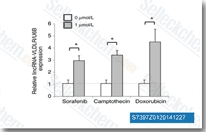
|
|
| S1040 | Sorafenib tosylate | Sorafenib tosylate is a multikinase inhibitor of Raf-1 and B-Raf with IC50 of 6 nM and 22 nM in cell-free assays, respectively. Sorafenib Tosylate inhibits VEGFR-2, VEGFR-3, PDGFR-β, Flt-3 and c-KIT with IC50 of 90 nM, 20 nM, 57 nM, 59 nM and 68 nM, respectively. Sorafenib Tosylate induces autophagy and apoptosis and activates ferroptosis with anti-tumor activity. |
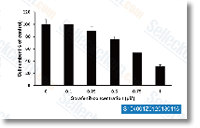
|
|
| S7781 | Sunitinib (SU-11248) | Sunitinib is a multi-targeted RTK inhibitor targeting VEGFR2 (Flk-1) and PDGFRβ with IC50 of 80 nM and 2 nM, and also inhibits c-Kit. Sunitinib is also a dose-dependent inhibitor of the autophosphorylation activity of IRE1α. Sunitinib induces autophagy and apoptosis. |

|
|
| S1490 | Ponatinib (AP24534) | Ponatinib is a novel, potent multi-target inhibitor of Abl, PDGFRα, VEGFR2, FGFR1 and Src with IC50 of 0.37 nM, 1.1 nM, 1.5 nM, 2.2 nM and 5.4 nM in cell-free assays, respectively. Ponatinib (AP24534) inhibits autophagy. |
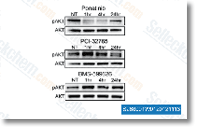
|
|
| S1178 | Regorafenib (BAY 73-4506) | Regorafenibは VEGFR1, VEGFR2, VEGFR3, PDGFRβ, Kit (c-Kit), RET (c-RET) および Raf-1 に対するマルチターゲット阻害剤であり、cell-free assay における IC50 はそれぞれ 13 nM/4.2 nM/46 nM, 22 nM, 7 nM, 1.5 nM, 2.5 nM です。Regorafenib はオートファジーを誘導します。 |
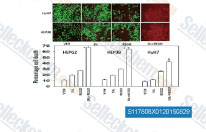
|
|
| S1005 | Axitinib (AG-013736) | Axitinib is a multi-target inhibitor of VEGFR1, VEGFR2, VEGFR3, PDGFRβ and c-Kit with IC50 of 0.1 nM, 0.2 nM, 0.1-0.3 nM, 1.6 nM and 1.7 nM in Porcine aorta endothelial cells, respectively. |
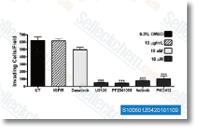
|
|
| S1042 | Sunitinib malate | Sunitinib malate is a multi-targeted RTK inhibitor targeting VEGFR2 (Flk-1) and PDGFRβ with IC50 of 80 nM and 2 nM in cell-free assays, and also inhibits c-Kit. Sunitinib Malate effectively inhibits autophosphorylation of Ire1α. Sunitinib Malate increases both death receptor and mitochondrial-dependent apoptosis. |
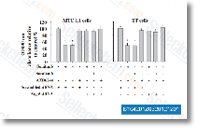
|
|
| S1029 | Lenalidomide (CC-5013) | Lenalidomide is a TNF-α secretion inhibitor with IC50 of 13 nM in PBMCs. Lenalidomide (CC-5013) is a ligand of ubiquitin E3 ligase cereblon (CRBN), and it causes selective ubiquitination and degradation of two lymphoid transcription factors, IKZF1 and IKZF3, by the CRBN-CRL4 ubiquitin ligase. Lenalidomide promotes cleaved caspase-3 expression and inhibit VEGF expression and induces apoptosis. |
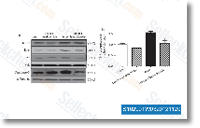
|
|
| S1119 | Cabozantinib (XL184) | カボザンチニブ (Cabozantinib (XL184, BMS-907351)) は強力な VEGFR2 阻害剤であり、IC50 は 0.035 nM です。また c-Met, Ret, Kit, Flt-1/3/4, Tie2 および AXL に対しても阻害活性があり、cell-free assay における IC50 はそれぞれ 1.3 nM, 4 nM, 4.6 nM, 12 nM/11.3 nM/6 nM, 14.3 nM, 7 nM です。カボザンチニブは大腸がん細胞において AKT/GSK-3β/NF-κB 経路を介して PUMA 依存性アポトーシス (PUMA-dependent apoptosis) を誘発します。 |
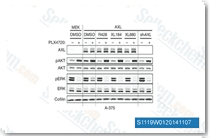
|
|
| S1010 | Nintedanib (BIBF 1120) | Nintedanib is a potent triple angiokinase inhibitor for VEGFR1/2/3, FGFR1/2/3 and PDGFRα/β with IC50 of 34 nM/13 nM/13 nM, 69 nM/37 nM/108 nM and 59 nM/65 nM in cell-free assays. Phase 3. |
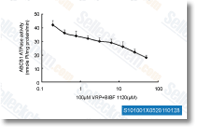
|
|
| S1264 | PD173074 | PD173074 is a potent FGFR1 inhibitor with IC50 of ~25 nM and also inhibits VEGFR2 with IC50 of 100-200 nM in cell-free assays, ~1000-fold selective for FGFR1 than PDGFR and c-Src. PD173074 reduces proliferation and promotes apoptosis in gastric cancer cells. |
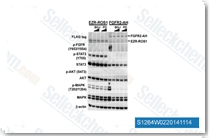
|
|
| S1046 | Vandetanib | Vandetanib is a potent inhibitor of VEGFR2 with IC50 of 40 nM in a cell-free assay. It also inhibits VEGFR3 and EGFR with IC50 of 110 nM and 500 nM, respectively. Not sensitive to PDGFRβ, Flt1, Tie-2 and FGFR1 with IC50 of 1.1-3.6 μM. No activity against MEK, CDK2, c-Kit, erbB2, FAK, PDK1, Akt and IGF-1R with IC50 above 10 μM. Vandetanib (ZD6474) increases apoptosis and induces autophagy by increasing the level of reactive oxygen species (ROS). |
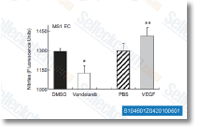
|
|
| S1164 | Lenvatinib (E7080) | レンバチニブ (Lenvatinib (E7080)) はマルチターゲット阻害剤の一種であり、主に VEGFR2(KDR)/VEGFR3(Flt-4) に対して活性を示し IC50 は 4 nM/5.2 nMである一方、VEGFR1/Flt-1に対しては活性が弱く、cell-free assay において FGFR1, PDGFRα/βよりも VEGFR2/3 に対して 10 倍高い選択性を示します。レンバチニブ (E7080) はまた FGFR1-4, PDGFR, Kit (c-Kit), RET (c-RET) も阻害し、強力な抗腫瘍活性を呈します。 |
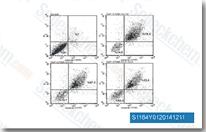
|
|
| S4001 | Cabozantinib malate | Cabozantinib malate (XL184) is the malate of Cabozantinib, a potent VEGFR2 inhibitor with IC50 of 0.035 nM and also inhibits c-Met, Ret (c-Ret), Kit (c-Kit), Flt-1/3/4, Tie2, and AXL with IC50 of 1.3 nM, 4 nM, 4.6 nM, 12 nM/11.3 nM/6 nM, 14.3 nM and 7 nM in cell-free assays, respectively. Cabozantinib malate (XL184) induces apoptosis. |

|
|
| S1111 | Foretinib | Foretinib is an ATP-competitive inhibitor of HGFR and VEGFR, mostly for Met (c-Met) and KDR with IC50 of 0.4 nM and 0.9 nM in cell-free assays. Less potent against Ron, Flt-1/3/4, Kit (c-Kit), PDGFRα/β and Tie-2, and little activity to FGFR1 and EGFR. Phase 2. |
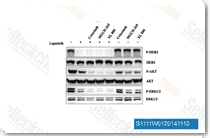
|
|
| S3012 | Pazopanib | Pazopanib (GW786034) is a novel multi-target inhibitor of VEGFR1, VEGFR2, VEGFR3, PDGFR, FGFR, c-Kit and c-Fms/CSF1R with IC50 of 10 nM, 30 nM, 47 nM, 84 nM, 74 nM, 140 nM and 146 nM in cell-free assays, respectively. Pazopanib induces cathepsin B activation and autophagy. |
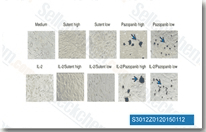
|
|
| S1017 | Cediranib (AZD2171) | Cediranib (AZD2171, NSC-732208) is a highly potent VEGFR(KDR) inhibitor with IC50 of <1 nM, also inhibits Flt1/4 with IC50 of 5 nM/≤3 nM, similar activity against c-Kit and PDGFRβ, 36-, 110-fold and >1000-fold selective more for VEGFR than PDGFR-α, CSF-1R and Flt3 in HUVEC cells. Cediranib (AZD2171) induces autophagic vacuole accumulation. Phase 3. |
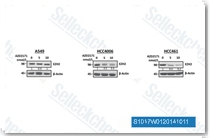
|
|
| S1035 | Pazopanib HCl | Pazopanib HCl is a novel multi-target inhibitor of VEGFR1, VEGFR2, VEGFR3, PDGFR, FGFR, c-Kit and c-Fms with IC50 of 10 nM, 30 nM, 47 nM, 84 nM, 74 nM, 140 nM and 146 nM in cell-free assays, respectively. Pazopanib induces autophagic Type II cell death. |
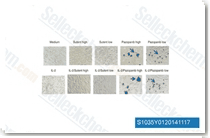
|
|
| S1018 | Dovitinib (TKI-258) | Dovitinib (TKI258, CHIR258) is a multitargeted RTK inhibitor, mostly for class III (FLT3/c-Kit) with IC50 of 1 nM/2 nM, also potent to class IV (FGFR1/3) and class V (VEGFR1-4) RTKs with IC50 of 8-13 nM, less potent to InsR, EGFR, c-Met, EphA2, Tie2, IGF-1R and HER2 in cell-free assays. Phase 4. |
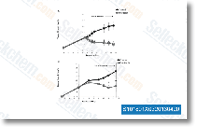
|
|
| S1101 | Vatalanib (PTK787) 2HCl | Vatalanib 2HCl (PTK787, ZK 222584, cpg-79787) is an inhibitor of VEGFR2/KDR with IC50 of 37 nM in a cell-free assay, less potent against VEGFR1/Flt-1, 18-fold against VEGFR3/Flt-4. Phase 3. |
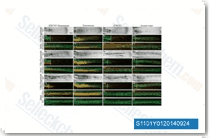
|
|
| S8064 | Midostaurin (PKC412) | Midostaurin is a multi-targeted kinase inhibitor, including PKCα/β/γ, Syk, Flk-1, Akt, PKA, c-Kit, c-Fgr, c-Src, FLT3, PDFRβ and VEGFR1/2 with IC50 ranging from 80-500 nM. |
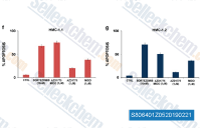
|
|
| S5077 | Regorafenib (BAY-734506) Monohydrate | Regorafenib (BAY-734506, Fluoro-sorafenib, Resihance, Stivarga) Monohydrate is a novel oral multikinase inhibitor with IC50 values of 13, 4.2, 46, 22, 7, 1.5, 2.5, 28, 19 nM for VEGFR1, murine VEGFR2, murine VEGFR3, PDGFR-β, Kit (c-Kit), RET (c-RET), RAF-1, B-RAF and B-RAF(V600E) respectively. | ||
| S1207 | Tivozanib | Tivozanib is a potent and selective VEGFR inhibitor for VEGFR1/2/3 with IC50 of 30 nM/6.5 nM/15 nM, and also inhibits PDGFR and c-Kit, low activity observed against FGFR-1, Flt3, c-Met, EGFR and IGF-1R. Phase 3. |
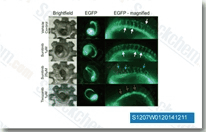
|
|
| A2006 | Bevacizumab (anti-VEGF) | Bevacizumab (anti-VEGF, Avastin) is a humanized anti-VEGF monoclonal antibody which binds to and neutralizes all human VEGF-A isoforms and bioactive proteolytic fragments, MW:149 KD. |
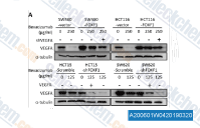
|
|
| S8401 | Erdafitinib (JNJ-42756493) | Erdafitinib is a potent and selective orally bioavailable, pan fibroblast growth factor receptor (FGFR) inhibitor with potential antineoplastic activity. Erdafitinib also binds to RET (c-RET), CSF-1R, PDGFR-α/PDGFR-β, FLT4, Kit (c-Kit) and VEGFR-2 and induces cellular apoptosis. |
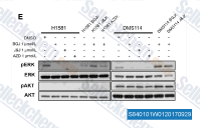
|
|
| S1003 | Linifanib (ABT-869) | Linifanib (ABT-869, AL39324, RG3635) is a novel, potent ATP-competitive VEGFR/PDGFR inhibitor for KDR, CSF-1R, Flt-1/3 and PDGFRβ with IC50 of 4 nM, 3 nM, 3 nM/4 nM and 66 nM respectively, mostly effective in mutant kinase-dependent cancer cells (i.e. FLT3). Linifanib (ABT-869) induces autophagy and apoptosis. Phase 3. |
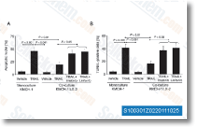
|
|
| S8726 | Anlotinib (AL3818) dihydrochloride | Anlotinib (AL3818) is a highly potent and selective VEGFR2 inhibitor with IC50 less than 1 nM. It has broad-spectrum antitumor potential in clinical trials. Please use saline solution rather than PBS for dilutions. PBS may cause precipitation. | ||
| S7765 | Dovitinib (TKI258) Lactate monohydrate | Dovitinib (TKI258) Lactate monohydrate is the Lactate of Dovitinib, which is a multitargeted RTK inhibitor, mostly for class III (FLT3/c-Kit) with IC50 of 1 nM/2 nM, also potent to class IV (FGFR1/3) and class V (VEGFR1-4) RTKs with IC50 of 8-13 nM, less potent to InsR, EGFR, c-Met, EphA2, Tie2, IGFR1 and HER2. Phase 4. |
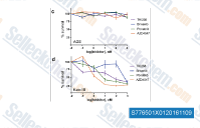
|
|
| S5240 | Lenvatinib Mesylate | Lenvatinib Mesylate is a synthetic, orally available tyrosine kinase inhibitor that inhibits vascular endothelial growth factor receptor (VEGFR1-3), fibroblast growth factor receptor (FGFR1-4), platelet-derived growth factor receptor α (PDGFRα), stem cell factor receptor (Kit (c-Kit)), and rearranged during transfection (RET (c-RET)). Lenvatinib Mesylate has potential antineoplastic activity. | ||
| S2161 | RAF265 (CHIR-265) | RAF265 (CHIR-265) is a potent selective inhibitor of C-Raf/B-Raf/B-Raf V600E with IC50 of 3-60 nM, and exhibits potent inhibition on VEGFR2 phosphorylation with EC50 of 30 nM in cell-free assays. RAF265 (CHIR-265) induces cell cycle arrest and apoptosis. Phase 2. |
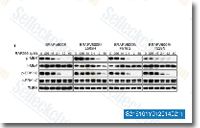
|
|
| S2842 | SAR131675 | SAR131675 is a VEGFR3 inhibitor with IC50/Ki of 23 nM/12 nM in cell-free assays, about 50- and 10-fold more selective for VEGFR3 than VEGFR1/2, little activity against Akt1, CDKs, PLK1, EGFR, IGF-1R, c-Met, Flt2 etc. |
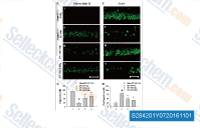
|
|
| S5248 | Apatinib | Apatinib (Rivoceranib, YN968D1) is a potent inhibitor of the VEGF signaling pathway with IC50 values of 1 nM, 13 nM, 429 nM and 530 nM for VEGFR-2, Ret (c-Ret), c-Kit and c-Src, respectively. Apatinib induces both autophagy and apoptosis. | ||
| S2221 | Apatinib (YN968D1) mesylate | Apatinib mesylate (YN968D1, Rivoceranib) is a potent inhibitor of the VEGF signaling pathway with IC50 values of 1 nM, 13 nM, 429 nM and 530 nM for VEGFR-2, Ret (c-Ret), c-Kit and c-Src, respectively. Apatinib mesylate induces both autophagy and apoptosis. | ||
| S4947 | Regorafenib Hydrochloride | Regorafenib (Stivarga, BAY 73-4506) Hydrochloride is a multi-target inhibitor for VEGFR1, Murine VEGFR2/3, PDGFRβ, Kit (c-Kit), RET (c-RET) and Raf-1 with IC50 of 13 nM, 4.2 nM/46 nM, 22 nM, 7 nM, 1.5 nM and 2.5 nM, respectively. | ||
| S1363 | Ki8751 | Ki8751 is a potent and selective inhibitor of VEGFR2 with IC50 of 0.9 nM, >40-fold selective for VEGFR2 than c-Kit, PDGFRα and FGFR-2, little activity to EGFR, HGFR and InsR. |
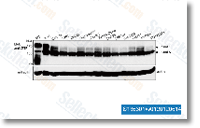
|
|
| S2896 | ZM 323881 HCl | ZM 323881 is a potent and selective VEGFR2 inhibitor with IC50 of <2 nM, almost no activity on VEGFR1, PDGFRβ, FGFR1, EGFR and ErbB2. |

|
|
| S2845 | Semaxanib (SU5416) | Semaxanib (SU5416, semaxinib) is a potent and selective VEGFR(Flk-1/KDR) inhibitor with IC50 of 1.23 μM, 20-fold more selective for VEGFR than PDGFRβ, lack of activity against EGFR, InsR and FGFR. Phase 3.Semaxanib (SU5416) can be used to induce animal models of Chronic Intermittent Hypoxia. |
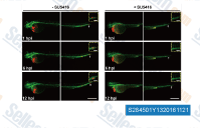
|
|
| S7057 | LY2874455 | LY2874455 is a pan-FGFR inhibitor with IC50 of 2.8 nM, 2.6 nM, 6.4 nM, and 6 nM for FGFR1, FGFR2, FGFR3, and FGFR4, respectively, and also inhibits VEGFR2 activity with IC50 of 7 nM. Phase 1. |
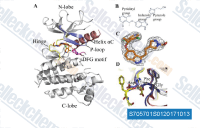
|
|
| S5234 | Nintedanib Ethanesulfonate Salt | Nintedanib (Intedanib, BIBF 1120) is a small molecule tyrosine-kinase inhibitor with IC50 of 34 nM/13 nM/13 nM, 69 nM/37 nM/108 nM and 59 nM/65 nM for VEGFR1/2/3, FGFR1/2/3 and PDGFRα/β, respectively. | ||
| S7667 | SU5402 | SU5402 is a potent multi-targeted receptor tyrosine kinase inhibitor with IC50 of 20 nM, 30 nM, and 510 nM for VEGFR2, FGFR1, and PDGF-Rβ, respectively. |
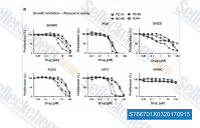
|
|
| S1486 | AEE788 (NVP-AEE788) | AEE788 (NVP-AEE788) is a potent inhibitor of EGFR and HER2/ErbB2 with IC50 of 2 nM and 6 nM, less potent to VEGFR2/KDR, c-Abl, c-Src, and Flt-1, does not inhibit Ins-R, IGF-1R, PKCα and CDK1. Phase 1/2. |
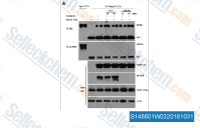
|
|
| S5242 | Cediranib Maleate | Cediranib Maleate (AZD2171) is the maleate salt of Cediranib, which is a potent inhibitor of VEGFR with IC50 of <1 nM and also inhibits Flt1/4 with IC50 of 5 nM/≤3 nM. | ||
| S1032 | Motesanib Diphosphate (AMG-706) | Motesanib Diphosphate (AMG-706) is a potent ATP-competitive inhibitor of VEGFR1/2/3 with IC50 of 2 nM/3 nM/6 nM, respectively; similar activity against Kit (c-Kit), ~10-fold more selective for VEGFR than PDGFR and Ret. Phase 3. |
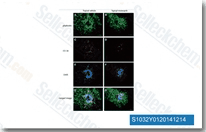
|
|
| S1361 | MGCD-265 analog | MGCD-265 is a potent, multi-target and ATP-competitive inhibitor of c-Met and VEGFR1/2/3 with IC50 of 1 nM, 3 nM/3 nM/4 nM, respectively; also inhibits Ron and Tie2. Phase 1/2. |
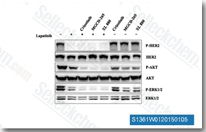
|
|
| S1084 | Brivanib (BMS-540215) | Brivanib is an ATP-competitive inhibitor against VEGFR2 with IC50 of 25 nM, moderate potency against VEGFR-1 and FGFR-1, but >240-fold against PDGFR-β. Phase 3. |
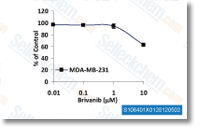
|
|
| S2897 | ZM 306416 | ZM 306416 (CB 676475) is a VEGFR (Flt and KDR) inhibitor for VEGFR1 with IC50 of 0.33 μM, but also found to inhibit EGFR with IC50 of <10 nM. |
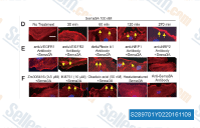
|
|
| S5793 | Motesanib (AMG-706) | Motesanib (AMG-706) is an orally bioavailable receptor tyrosine kinase inhibitor with IC50 values of 2 nM, 3 nM, 6 nM, 8 nM, 84 nM, 59 nM for VEGFR1, VEGFR2, VEGFR3, Kit, PDGFR and Ret, respectively. | ||
| S1181 | ENMD-2076 | ENMD-2076 has selective activity against Aurora A and Flt3 with IC50 of 14 nM and 1.86 nM, 25-fold selective for Aurora A than over Aurora B and less potent to RET, SRC, NTRK1/TRKA, CSF1R/FMS, VEGFR2/KDR, FGFR and PDGFRα. ENMD-2076 inhibits the growth of a wide range of human solid tumor and hematopoietic cancer cell lines with IC50 from 0.025 to 0.7 μM, which induces apoptosis and G2/M phase arrest. Phase 2. |
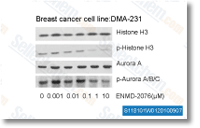
|
|
| S1171 | CYC116 | CYC116 is a potent inhibitor of Aurora A/B with Ki of 8.0 nM/9.2 nM, is less potent to VEGFR2 (Ki of 44 nM), with 50-fold greater potency than CDKs, not active against PKA, Akt/PKB, PKC, no effect on GSK-3α/β, CK2, Plk1 and SAPK2A. Phase 1. |
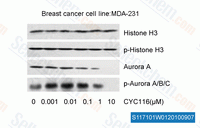
|
|
| S2859 | Golvatinib (E7050) | Golvatinib (E7050) is a dual c-Met and VEGFR-2 inhibitor with IC50 of 14 nM and 16 nM, does not inhibit bFGF-stimulated HUVEC growth (up to 1000 nM). Phase 1/2. |
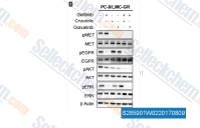
|
|
| S1220 | OSI-930 | OSI-930 is a potent inhibitor of Kit (c-Kit), KDR and CSF-1R with IC50 of 80 nM, 9 nM and 15 nM, respectively; also potent to Flt-1, c-Raf and Lck and low activity against PDGFRα/β, Flt-3 and Abl. Phase 1. |
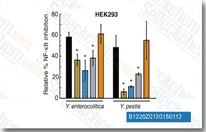
|
|
| S2622 | PP121 | PP-121 is a multi-targeted inhibitor of PDGFR, Hck, mTOR, VEGFR2, Src and Abl with IC50 of 2 nM, 8 nM, 10 nM, 12 nM, 14 nM and 18 nM, also inhibits DNA-PK with IC50 of 60 nM. |
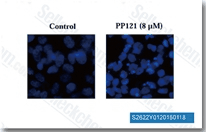
|
|
| S1557 | KRN 633 | KRN 633 is an ATP-competitive inhibitor of VEGFR1/2/3 with IC50 of 170 nM/160 nM/125 nM, weakly inhibits PDGFR-α/β and c-Kit, does not block the phosphorylation of FGFR-1, EGFR or c-Met in cell. |
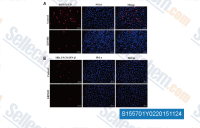
|
|
| S2231 | Telatinib | Telatinib (BAY 57-9352) is a potent inhibitor of VEGFR2/3, c-Kit and PDGFRα with IC50 of 6 nM/4 nM, 1 nM and 15 nM, respectively. Phase 2. |
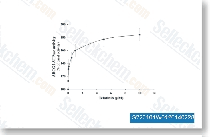
|
|
| S5667 | Fruquintinib (HMPL-013) | Fruquintinib is a small molecule inhibitor with strong potency and high selectivity against VEGFR family. It inhibits VEGFR 1, 2, 3, with IC50 values of 33 nM, 35 nM and 0.5 nM, respectively and shows only weak inhibition of RET, FGFR-1 and c-kit kinases. | ||
| S8573 | Sitravatinib (MGCD516) | Sitravatinib (MGCD516, MG-516) is a novel small molecule inhibitor targeting multiple RTKs involved in driving sarcoma cell growth, including c-Kit, PDGFRβ, PDGFRα, c-Met, and Axl. | ||
| S7258 | SKLB1002 | SKLB1002 is a potent and ATP-competitive VEGFR2 inhibitor with IC50 of 32 nM. |
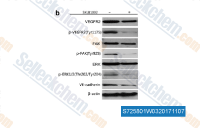
|
|
| S7003 | AZD2932 | AZD2932 is a potent and mutil-targeted protein tyrosine kinase inhibitor with IC50 of 8 nM, 4 nM, 7 nM, and 9 nM for VEGFR-2, PDGFRβ, Flt-3, and c-Kit, respectively. | ||
| S2366 | Taxifolin (Dihydroquercetin) | Taxifolin, type I inhibitor for VEGFR-2 kinase, is a flavonoid in many plants such as Taxus chinensis, Siberian larch, Cedrus deodara and so on. | ||
| S1138 | Brivanib Alaninate (BMS-582664) | Brivanib alaninate (BMS-582664) is the prodrug of BMS-540215, an ATP-competitive inhibitor against VEGFR2 with IC50 of 25 nM. |

|
|
| S8189 | BAW2881 (NVP-BAW2881) | BAW2881 (NVP-BAW2881) is a novel vascular endothelial growth factor (VEGF) receptor tyrosine-kinase inhibitor that potently inhibits VEGFR1-3 at 1.0-4.3 nanomolar (nM) concentrations and inhibits PDGFRβ, c-Kit, and RET (c-RET) at 45-72 nM concentrations. | ||
| S0504 | SU14813 | SU14813 (SU 014813) is a multiple receptor tyrosine kinase inhibitor with IC50 of 50 nM, 2 nM, 4 nM and 15 nM for VEGFR2, VEGFR1, PDGFRβ and Kit (c-Kit). SU14813 exhibits potent antiangiogenic and antitumor activity. | ||
| S6535 | SU1498 | SU1498, a powerful inhibitor of KDR (IC50 = 0.7 μM), stimulates accumulation of phosphorylated ERK1/2 in endothelial cells. | ||
| S8721 | PDGFR inhibitor 1 | PDGFR inhibitor 1 is an orally bioavailable switch pocket control inhibitor of wild-type and mutated forms of Kit (c-Kit) and PDGFR with potential antineoplastic activity. It also inhibits several other kinases, including VEGFR2, TIE2, PDGFR-beta and CSF1R, thereby further inhibiting tumor cell growth. | ||
| S0278 | SU5614 | SU5614 (Chloro-SU5416, Chloro-Semaxanib) is a small molecule receptor tyrosine kinases (RTK) inhibitor of VEGFR-2, c-kit, and both wild-type and mutant FLT3. SU5614 reduces cell proliferation and induces apoptosis. | ||
| S6526 | SKLB 610 | SKLB-610 is a multi-target inhibitor of the tyrosine kinases. It is most potent against VEGFR2 and exhibits slightly weaker inhibitor of FGFR2 and PDGFR. | ||
| S6412 | Altiratinib | Altiratinib (DCC-2701) is a potent single-digit nanomolar inhibitor of TRK, Met (c-Met), TIE2, and VEGFR2 kinases with IC50 vaules of 0.9 nM, 4.6 nM, and 0.8 nM for TRKA, B, and C, respectively. It inhibits Met (c-Met) and Met (c-Met) mutant with IC50 values in the range of 0.3-6 nM. | ||
| S6514 | SU5408 | SU5408 (VEGFR2 Kinase Inhibitor I) is a potent and selective inhibitor of VEGFR2 Kinase with IC50 of 70 nM. | ||
| S2201 | BMS-794833 | BMS-794833 is a potent ATP competitive inhibitor of Met (c-Met)/VEGFR2 with IC50 of 1.7 nM/15 nM, also inhibits Ron, Axl and Flt3 with IC50 of <3 nM; a prodrug of BMS-817378. Phase 1. | ||
| S0290 | SU5204 | SU5204, an analogue of SU5025, is a pharmacological inhibitor of VEGFR2. | ||
| A2003 | Ramucirumab (anti-VEGFR2) | Ramucirumab is a monoclonal antibody of the IgG1 class that binds to VEGF-R2 and prevents its activation. The IC50 value for blocking KDR binding to VEGF is 0.8 nM for ramucirumab, MW : 143.6 KD. | ||
| S0487 | Sulfatinib | Sulfatinib is a potent and highly selective tyrosine kinase inhibitor against VEGFR1, VEGFR2, VEGFR3, FGFR1 and CSF1R with IC50 of 2 nM, 24 nM, 1 nM, 15 nM and 4 nM, respectively. Sulfatinib shows encouraging antitumor activity and manageable toxicities in patients with advanced NETs. | ||
| F2527 | VEGFA Antibody [G24N11] | |||
| F1598 | VEGF Receptor 1 Antibody [E17N8] | |||
| S2018 | ENMD-2076 L-(+)-Tartaric acid | ENMD-2076 L-(+)-Tartaric acid is the tartaric acid of ENMD-2076, selective activity against Aurora A and Flt3 with IC50 of 14 nM and 1.86 nM, 25-fold more selective for Aurora A than Aurora B and less potent to VEGFR2/KDR and VEGFR3, FGFR1 and FGFR2 and PDGFRα. Phase 2. |

|
|
| S6520 | WHI-P180 | WHI-P180 is a multi-kinase inhibitor with IC50 values of 4.5 and 66 nM for the human proto-oncogene RET (c-RET) and kinase insert domain receptor (KDR), respectively. | ||
| S6543 | ZD-4190 | ZD-4190 is a submicromolar inhibitor of VEGF RTK activity in vitro with IC50 values of 29 ± 4 nM and 708 ± 63 nM for KDR and Flt-1, respectively. | ||
| S7688 | Ki20227 | Ki20227 is an orally active and highly selective inhibitor of c-Fms tyrosine kinase(CSF1R) with IC50 of 2 nM, 12 nM, 451 nM and 217 nM for c-Fms, vascular endothelial growth factor receptor-2 (KDR/VEGFR-2), stem cell factor receptor (c-Kit), and platelet-derived growth factor receptor beta (PDGFRβ), respectively. | ||
| S5272 | Toceranib phosphate | Toceranib phosphate (Palladia, SU11654), the phosphate salt of toceranib, is a selective inhibitor of the tyrosine kinase activity of several members of the split kinase RTK family, including Flk-1/KDR, PDGFR, and Kit with Ki values of 6 nM and 5 nM for Flk-1/KDR and PDGFRβ, respectively. | ||
| S8188 | BFH772 | BFH772 is a novel potent oral VEGFR2 inhibitor, targeting VEGFR2 kinase with IC50 of 3 nM. | ||
| S0291 | SU5208 | SU5208(3-[(Thien-2-yl)methylene]-2-indolinone) is an inhibitor of vascular endothelial growth factor receptor-2 (VEGFR2). | ||
| A2126 | Anti-mouse VEGFR-2-InVivo | Anti-mouse VEGFR-2-InVivo (Clone: DC101) monoclonal antibody reacts with mouse VEGFR-2 (vascular endothelial growth factor receptor 2) also known as CD309, KDR, and Flk-1 and inhibit VEGFR-2 signaling in vivo. VEGFR-2 plays a key role in vascular development and permeability. | ||
| E2397 | hVEGF-IN-1 | hVEGF-IN-1, a quinazoline derivative, specifically binds to the G-rich sequence in the internal ribosome entry site A (IRES-A) with a Kd of 0.928 μM, therefore destabilizes the G-quadruplex structure, , also hinders tumor cells migration and represses tumor growth by decreasing VEGF-A protein expression. | ||
| S8882 | ODM-203 | ODM-203 is a selective inhibitor of FGFR and VEGFR with ic50s of 11 nM,16 nM,6 nM, 35 nM,26 nM,9 nM,5 nM for recombinant FGFR1, FGFR2, FGFR3,FGFR4, VEGFR1, VEGFR2 and VEGFR3, respectively. | ||
| F2509New | VEGFD Antibody [K3P16] | |||
| S0763 | Tyrphostin AG1433 | Tyrphostin AG1433 (AG1433, SU1433) is a selective platelet-derived growth factor receptor β (PDGFRβ) and vascular endothelial growth factor receptor 2 (VEGFR-2, Flk-1/KDR) inhibitor with IC50s of 5.0 μM and 9.3 μM, respectively. | ||
| S0765 | MAZ51 | MAZ51 is a potent and selective inhibitor of vascular endothelial growth factor receptor (VEGFR)-3 (Flt-4) tyrosine kinase. MAZ51 induces cell rounding and G2/M cell cycle arrest in glioma cells through phosphorylation of Akt/GSK3β and activation of RhoA. MAZ51 inhibits the proliferation and induces the apoptosis of a variety of non-VEGFR-3-expressing tumor cell lines. | ||
| E0499 | 4SC-203 | 4SC-203 (SC71710) is a multikinase inhibitor with potential antineoplastic activity. 4SC-203 selectively inhibits FMS-related tyrosine kinase 3 (FLT3/STK1), FLT3 mutated forms, and vascular endothelial growth factor receptors (VEGFRs). | ||
| E2656 | R1530 | R1530 is a highly potent, orally bioavailable, dual-acting mitosis/angiogenesis inhibitor for the treatment of solid tumors, which can inhibit vascular endothelial growth factor receptor 2 (VEGFR2) and fibroblast growth factor receptors 1 (FGFR1) with IC50s of 10 nM and 28 nM, respectively. | ||
| S9621 | Donafenib (Sorafenib D3) | Donafenib (Sorafenib D3, Bay 43-9006 D3, CM-4307) is the deuterium labeled Sorafenib. Sorafenib is a multikinase inhibitor IC50s of 6 nM, 15 nM, 20 nM and 22 nM for Raf-1, mVEGFR-2, mVEGFR-3 and B-RAF, respectively. | ||
| E1078 | Emvododstat (PTC299) | Emvododstat(PTC299), a post-transcriptional inhibitor of pathogenic VEGF and dihydroorotate dehydrogenase(DHODH), inhibits VEGFA mRNA translation and abnormal cell proliferation. In HeLa cells PTC299 inhibits hypoxia-induced VEGFA protein production with an EC50 of 1.64 nM. | ||
| A2903 | Anti-VEGFR2 / KDR / CD309 (Imclone 6.64) | Anti-VEGFR2 / KDR / CD309 (Imclone 6.64) is a monoclonal antibody targated against vascular endothelial growth factor receptor-2 (VEGFR2) with anti-angiogenesis and anti-tumour activity. MW: 145.4 KD. | ||
| S2211 | AG-13958 | AG-13958 (AG-013958), a VEGFR tyrosine kinase inhibitor, is in clinical development with ST administration for treatment of choroidal neovascularization associated with age–related macular degeneration (AMD). | ||
| S5607 | 4,4'-Bis(4-aminophenoxy)biphenyl | 4,4'-Bis(4-aminophenoxy)biphenyl is a monomer for polyimide production. | ||
| S7647 | Lucitanib (E3810) hydrochloride | Lucitanib (E-3810, AL3810) hydrochloride is a dual inhibitor of Vascular endothelial growth factor receptor (VEGFR) and Fibroblast growth factor receptor (FGFR). Lucitanib hydrochloride (E-3810, AL3810) potently and selectively inhibits VEGFR1, VEGFR2, VEGFR3, FGFR1 and FGFR2 with IC50 of 7 nM, 25 nM, 10 nM, 17.5 nM, and 82.5 nM, respectively. | ||
| E0616 | Chiauranib | Chiauranib (CS2164) selectively inhibits multiple kinase targets aurora B kinase (AURKB), colony-stimulating factor 1 receptor (CSF1R), and vascular endothelial growth factor receptor (VEGFR)/platelet-derived growth factor receptor (PDGFR)/c-Kit , thereby inhibiting the rapid proliferation of tumor cells, enhancing the antitumor immunity, and inhibiting tumor angiogenesis, to achieve the anti-tumor efficacy. | ||
| S6870 | Ningetinib | Ningetinib (CT-053, DE-120, CT053PTSA) is a potent, orally bioavailable inhibitor of tyrosine kinase with IC50 of 6.7 nM, 1.9 nM and <1.0 nM for c-Met, VEGFR2 and Axl, respectively. Ningetinib exhibits antitumor activity. | ||
| S6843 | Vorolanib | Vorolanib (X-82,CM082) is an oral, multikinase, dual inhibitor of vascular endothelial growth factor receptor (VEGFR) and platelet-derived growth factor receptor (PDGFR) with antiangiogenic and antineoplastic activities. | ||
| F3049New | VEGF Receptor 2 Antibody [J9N19] | CD309 (FLK1),Flk-1,VEGF Receptor 2,VEGFR-2 | ||
| S6764 | Pamufetinib (TAS-115) | Pamufetinib (TAS-115) is a highly potent c-Met and VEGFR dual inhibitor with IC50s of 30 nM and 32 nM for recombinant VEGFR2 and recombinant MET, respectively. | ||
| S6939 | Nastorazepide | Nastorazepide (Z-360), a cholecystokinin-2/gastrin receptor (CCK2/gastrin receptor) antagonist, combines with gemcitabine prolonged survival and reduces gemcitabine-induced vascular endothelial growth factor (VEGF) expression in a pancreatic carcinoma orthotopic xenograft mouse. | ||
| S0377 | CS-2660 (JNJ-38158471) | CS-2660 (JNJ-38158471) 是一种耐受性良好的、口服有效的、高选择性的 VEGFR-2 抑制剂,IC50值为40 nM。CS-2660(JNJ-38158471)还抑制紧密相关的酪氨酸激酶,如 RET (c-RET) 和 Kit (c-Kit),IC50为180 nM和500 nM,但无明显活性 (>1 microM) 针对VEGFR-1和VEGFR-3。 | ||
| A2515 | Parsatuzumab (Anti-EGFL7) | Parsatuzumab (Anti-EGFL7) is a humanized monoclonal antibody targeting EGFL7. Parsatuzumab selectively blocks the interaction between EGFL7 and endothelial cells, potentially inhibiting vascular regrowth and reducing vascular endothelial growth factor (VEGF) inhibition. MW: 145.5 KD. | ||
| S9402 | (20R)-Protopanaxadiol | (20R)-Protopanaxadiol, isolated from the roots of Panax ginseng, has protective effect on myocardial ischemia. | ||
| A2979 | Olinvacimab (Anti-VEGFR2 / KDR / CD309) | Olinvacimab (Anti-VEGFR2 / KDR / CD309) is a fully human monoclonal antibody targeting VEGFR2. It has antiangiogenic activity and can be used for the research of recurrent glioblastoma and breast cancer. MW :146.88 KD | ||
| E4914 | Cabozantinib hydrochloride | Cabozantinib hydrochloride(XL184, BMS-907351 hydrochloride) is a potent small-molecule kinase inhibitor of c-MET and VEGFR2 with an IC50 of 1.3 nM, 0.035 nM respectively. It also inhibits RET, KIT, AXL, Tie2 and FLT3 with an IC50's of 5.2 nM, 4.6 nM, 7 nM, 14.3 nM, 11.3nM respectively. It can be promising agent for inhibiting tumor angiogenesis and metastasis in cancers with dysregulated MET and VEGFR signaling. | ||
| S4686 | Vitamin E | Vitamin E (D-alpha-Tocopherol) is a fat-soluble vitamin with potent antioxidant properties. It is a potent peroxyl radical scavenger and inhibits noncompetitively cyclooxygenase activity in many tissues, also inhibits angiogenesis and tumor dormancy through suppressing vascular endothelial growth factor (VEGF) gene transcription. | ||
| A2300 | Anti-VEGFR3 / FLT4 | Anti-VEGFR3 / FLT4 is a fully-human monoclonal antibody directed against (VEGFR-3; Flt-4) with antiangiogenic activity.Anti-VEGFR3 / FLT4 also plays a critical role in the embryonic vascular system development. | ||
| A2301 | Icrucumab (Anti-VEGFR1 / FLT1) | Icrucumab (Anti-VEGFR1 / FLT1) is a humanized Anti-VEGFR-1 IgG1 monoclonal antibody, with potential anti-tumor and anti-metastatic agent. It also act as a therapeutic anti-angiogenic agent in different pathological contexts. | ||
| A2302 | Anti-VEGFC | Anti-VEGFC is a fully human monoclonal antibody targeting the human vascular endothelial growth factor C (VEGFC or Flt4 ligand) with potential antiangiogenic activity and lymphangiogenesis. It also prevent metastasis. MW :145.5 KD. | ||
| A2303 | Anti-VEGFB | Anti-VEGFB (CSL346) is an antibody targeting VEGFA. MW:150 KD. | ||
| A2305 | Ranibizumab (Anti-VEGFA) | Ranibizumab (Anti-VEGFA) is a recombinant humanized IgG1 monoclonal antibody fragment that inhibits (VEGF-A) and degrades angiogenesis throughout the body and in the eye also interrupts the interaction of VEGF with its receptors, and thus prevents the subsequent growth of new blood vessels. | ||
| E0207 | Chebulinic acid | Chebulinic acid, a phenolic compound isolated from Terminalia chebula fruit, is a novel Influenza viral neuraminidase inhibitor. Chebulinic acid is a antiangiogenic agent through inhibiting the actions of VEGF. Chebulinic acid shows antitumour activity. | ||
| E4694 | EVT801 | EVT801 is a potent and selective inhibitor of VEGFR-3 with an IC50 of 11 nM. It exhibits potent antitumor effects and represents a promising anti-lymphangiogenic drug in patients with VEGFR-3 positive tumors. | ||
| S6808 | SU5205 | SU5205 is an inhibitor of VEGF receptor 2 (VEGFR2/FLK-1) with IC50 of 9.6 µM. | ||
| S6809 | SU5214 | SU5214 is an inhibitor of VEGF receptor 2 (VEGFR2/FLK-1) with IC50 of 14.8 µM and EGFR with IC50 of 36.7 µm, respectively. | ||
| E1435 | Tinengotinib | Tinengotinib (TT-00420) is a novel multiple kinase inhibitor that strongly inhibits Aurora A/B with IC50 values of 1.2/3.3 nM respectively. It also exhibits potent inhibitory activity on FGFR1/2/3, VEGFR1, JAK1/2, and CSF1R and can be used to treat several prominent signaling pathways in triple-negative breast cancer(TNBC). | ||
| E0142 | XL092 | XL092 (JUN04542) is an ATP-competitive inhibitor of multiple RTKs including MET, VEGFR2, AXL and MER, with IC50 values of 15 nM, 1.6 nM, 3.4 nM, and 7.2 nM in cell-based assays, respectively. | ||
| S7397 | Sorafenib (BAY 43-9006) | Sorafenib is a multikinase inhibitor of Raf-1 and B-Raf with IC50 of 6 nM and 22 nM in cell-free assays, respectively. Sorafenib inhibits VEGFR-2, VEGFR-3, PDGFR-β, Flt-3 and c-KIT with IC50 of 90 nM, 20 nM, 57 nM, 59 nM and 68 nM, respectively. Sorafenib induces autophagy and apoptosis and activates ferroptosis with anti-tumor activity. |

|
|
| S1040 | Sorafenib tosylate | Sorafenib tosylate is a multikinase inhibitor of Raf-1 and B-Raf with IC50 of 6 nM and 22 nM in cell-free assays, respectively. Sorafenib Tosylate inhibits VEGFR-2, VEGFR-3, PDGFR-β, Flt-3 and c-KIT with IC50 of 90 nM, 20 nM, 57 nM, 59 nM and 68 nM, respectively. Sorafenib Tosylate induces autophagy and apoptosis and activates ferroptosis with anti-tumor activity. |

|
|
| S7781 | Sunitinib (SU-11248) | Sunitinib is a multi-targeted RTK inhibitor targeting VEGFR2 (Flk-1) and PDGFRβ with IC50 of 80 nM and 2 nM, and also inhibits c-Kit. Sunitinib is also a dose-dependent inhibitor of the autophosphorylation activity of IRE1α. Sunitinib induces autophagy and apoptosis. |

|
|
| S1490 | Ponatinib (AP24534) | Ponatinib is a novel, potent multi-target inhibitor of Abl, PDGFRα, VEGFR2, FGFR1 and Src with IC50 of 0.37 nM, 1.1 nM, 1.5 nM, 2.2 nM and 5.4 nM in cell-free assays, respectively. Ponatinib (AP24534) inhibits autophagy. |

|
|
| S1178 | Regorafenib (BAY 73-4506) | Regorafenibは VEGFR1, VEGFR2, VEGFR3, PDGFRβ, Kit (c-Kit), RET (c-RET) および Raf-1 に対するマルチターゲット阻害剤であり、cell-free assay における IC50 はそれぞれ 13 nM/4.2 nM/46 nM, 22 nM, 7 nM, 1.5 nM, 2.5 nM です。Regorafenib はオートファジーを誘導します。 |

|
|
| S1005 | Axitinib (AG-013736) | Axitinib is a multi-target inhibitor of VEGFR1, VEGFR2, VEGFR3, PDGFRβ and c-Kit with IC50 of 0.1 nM, 0.2 nM, 0.1-0.3 nM, 1.6 nM and 1.7 nM in Porcine aorta endothelial cells, respectively. |

|
|
| S1042 | Sunitinib malate | Sunitinib malate is a multi-targeted RTK inhibitor targeting VEGFR2 (Flk-1) and PDGFRβ with IC50 of 80 nM and 2 nM in cell-free assays, and also inhibits c-Kit. Sunitinib Malate effectively inhibits autophosphorylation of Ire1α. Sunitinib Malate increases both death receptor and mitochondrial-dependent apoptosis. |

|
|
| S1029 | Lenalidomide (CC-5013) | Lenalidomide is a TNF-α secretion inhibitor with IC50 of 13 nM in PBMCs. Lenalidomide (CC-5013) is a ligand of ubiquitin E3 ligase cereblon (CRBN), and it causes selective ubiquitination and degradation of two lymphoid transcription factors, IKZF1 and IKZF3, by the CRBN-CRL4 ubiquitin ligase. Lenalidomide promotes cleaved caspase-3 expression and inhibit VEGF expression and induces apoptosis. |

|
|
| S1119 | Cabozantinib (XL184) | カボザンチニブ (Cabozantinib (XL184, BMS-907351)) は強力な VEGFR2 阻害剤であり、IC50 は 0.035 nM です。また c-Met, Ret, Kit, Flt-1/3/4, Tie2 および AXL に対しても阻害活性があり、cell-free assay における IC50 はそれぞれ 1.3 nM, 4 nM, 4.6 nM, 12 nM/11.3 nM/6 nM, 14.3 nM, 7 nM です。カボザンチニブは大腸がん細胞において AKT/GSK-3β/NF-κB 経路を介して PUMA 依存性アポトーシス (PUMA-dependent apoptosis) を誘発します。 |

|
|
| S1010 | Nintedanib (BIBF 1120) | Nintedanib is a potent triple angiokinase inhibitor for VEGFR1/2/3, FGFR1/2/3 and PDGFRα/β with IC50 of 34 nM/13 nM/13 nM, 69 nM/37 nM/108 nM and 59 nM/65 nM in cell-free assays. Phase 3. |

|
|
| S1264 | PD173074 | PD173074 is a potent FGFR1 inhibitor with IC50 of ~25 nM and also inhibits VEGFR2 with IC50 of 100-200 nM in cell-free assays, ~1000-fold selective for FGFR1 than PDGFR and c-Src. PD173074 reduces proliferation and promotes apoptosis in gastric cancer cells. |

|
|
| S1046 | Vandetanib | Vandetanib is a potent inhibitor of VEGFR2 with IC50 of 40 nM in a cell-free assay. It also inhibits VEGFR3 and EGFR with IC50 of 110 nM and 500 nM, respectively. Not sensitive to PDGFRβ, Flt1, Tie-2 and FGFR1 with IC50 of 1.1-3.6 μM. No activity against MEK, CDK2, c-Kit, erbB2, FAK, PDK1, Akt and IGF-1R with IC50 above 10 μM. Vandetanib (ZD6474) increases apoptosis and induces autophagy by increasing the level of reactive oxygen species (ROS). |

|
|
| S1164 | Lenvatinib (E7080) | レンバチニブ (Lenvatinib (E7080)) はマルチターゲット阻害剤の一種であり、主に VEGFR2(KDR)/VEGFR3(Flt-4) に対して活性を示し IC50 は 4 nM/5.2 nMである一方、VEGFR1/Flt-1に対しては活性が弱く、cell-free assay において FGFR1, PDGFRα/βよりも VEGFR2/3 に対して 10 倍高い選択性を示します。レンバチニブ (E7080) はまた FGFR1-4, PDGFR, Kit (c-Kit), RET (c-RET) も阻害し、強力な抗腫瘍活性を呈します。 |

|
|
| S4001 | Cabozantinib malate | Cabozantinib malate (XL184) is the malate of Cabozantinib, a potent VEGFR2 inhibitor with IC50 of 0.035 nM and also inhibits c-Met, Ret (c-Ret), Kit (c-Kit), Flt-1/3/4, Tie2, and AXL with IC50 of 1.3 nM, 4 nM, 4.6 nM, 12 nM/11.3 nM/6 nM, 14.3 nM and 7 nM in cell-free assays, respectively. Cabozantinib malate (XL184) induces apoptosis. |

|
|
| S1111 | Foretinib | Foretinib is an ATP-competitive inhibitor of HGFR and VEGFR, mostly for Met (c-Met) and KDR with IC50 of 0.4 nM and 0.9 nM in cell-free assays. Less potent against Ron, Flt-1/3/4, Kit (c-Kit), PDGFRα/β and Tie-2, and little activity to FGFR1 and EGFR. Phase 2. |

|
|
| S3012 | Pazopanib | Pazopanib (GW786034) is a novel multi-target inhibitor of VEGFR1, VEGFR2, VEGFR3, PDGFR, FGFR, c-Kit and c-Fms/CSF1R with IC50 of 10 nM, 30 nM, 47 nM, 84 nM, 74 nM, 140 nM and 146 nM in cell-free assays, respectively. Pazopanib induces cathepsin B activation and autophagy. |

|
|
| S1017 | Cediranib (AZD2171) | Cediranib (AZD2171, NSC-732208) is a highly potent VEGFR(KDR) inhibitor with IC50 of <1 nM, also inhibits Flt1/4 with IC50 of 5 nM/≤3 nM, similar activity against c-Kit and PDGFRβ, 36-, 110-fold and >1000-fold selective more for VEGFR than PDGFR-α, CSF-1R and Flt3 in HUVEC cells. Cediranib (AZD2171) induces autophagic vacuole accumulation. Phase 3. |

|
|
| S1035 | Pazopanib HCl | Pazopanib HCl is a novel multi-target inhibitor of VEGFR1, VEGFR2, VEGFR3, PDGFR, FGFR, c-Kit and c-Fms with IC50 of 10 nM, 30 nM, 47 nM, 84 nM, 74 nM, 140 nM and 146 nM in cell-free assays, respectively. Pazopanib induces autophagic Type II cell death. |

|
|
| S1018 | Dovitinib (TKI-258) | Dovitinib (TKI258, CHIR258) is a multitargeted RTK inhibitor, mostly for class III (FLT3/c-Kit) with IC50 of 1 nM/2 nM, also potent to class IV (FGFR1/3) and class V (VEGFR1-4) RTKs with IC50 of 8-13 nM, less potent to InsR, EGFR, c-Met, EphA2, Tie2, IGF-1R and HER2 in cell-free assays. Phase 4. |

|
|
| S1101 | Vatalanib (PTK787) 2HCl | Vatalanib 2HCl (PTK787, ZK 222584, cpg-79787) is an inhibitor of VEGFR2/KDR with IC50 of 37 nM in a cell-free assay, less potent against VEGFR1/Flt-1, 18-fold against VEGFR3/Flt-4. Phase 3. |

|
|
| S8064 | Midostaurin (PKC412) | Midostaurin is a multi-targeted kinase inhibitor, including PKCα/β/γ, Syk, Flk-1, Akt, PKA, c-Kit, c-Fgr, c-Src, FLT3, PDFRβ and VEGFR1/2 with IC50 ranging from 80-500 nM. |

|
|
| S5077 | Regorafenib (BAY-734506) Monohydrate | Regorafenib (BAY-734506, Fluoro-sorafenib, Resihance, Stivarga) Monohydrate is a novel oral multikinase inhibitor with IC50 values of 13, 4.2, 46, 22, 7, 1.5, 2.5, 28, 19 nM for VEGFR1, murine VEGFR2, murine VEGFR3, PDGFR-β, Kit (c-Kit), RET (c-RET), RAF-1, B-RAF and B-RAF(V600E) respectively. | ||
| S1207 | Tivozanib | Tivozanib is a potent and selective VEGFR inhibitor for VEGFR1/2/3 with IC50 of 30 nM/6.5 nM/15 nM, and also inhibits PDGFR and c-Kit, low activity observed against FGFR-1, Flt3, c-Met, EGFR and IGF-1R. Phase 3. |

|
|
| S8401 | Erdafitinib (JNJ-42756493) | Erdafitinib is a potent and selective orally bioavailable, pan fibroblast growth factor receptor (FGFR) inhibitor with potential antineoplastic activity. Erdafitinib also binds to RET (c-RET), CSF-1R, PDGFR-α/PDGFR-β, FLT4, Kit (c-Kit) and VEGFR-2 and induces cellular apoptosis. |

|
|
| S1003 | Linifanib (ABT-869) | Linifanib (ABT-869, AL39324, RG3635) is a novel, potent ATP-competitive VEGFR/PDGFR inhibitor for KDR, CSF-1R, Flt-1/3 and PDGFRβ with IC50 of 4 nM, 3 nM, 3 nM/4 nM and 66 nM respectively, mostly effective in mutant kinase-dependent cancer cells (i.e. FLT3). Linifanib (ABT-869) induces autophagy and apoptosis. Phase 3. |

|
|
| S8726 | Anlotinib (AL3818) dihydrochloride | Anlotinib (AL3818) is a highly potent and selective VEGFR2 inhibitor with IC50 less than 1 nM. It has broad-spectrum antitumor potential in clinical trials. Please use saline solution rather than PBS for dilutions. PBS may cause precipitation. | ||
| S7765 | Dovitinib (TKI258) Lactate monohydrate | Dovitinib (TKI258) Lactate monohydrate is the Lactate of Dovitinib, which is a multitargeted RTK inhibitor, mostly for class III (FLT3/c-Kit) with IC50 of 1 nM/2 nM, also potent to class IV (FGFR1/3) and class V (VEGFR1-4) RTKs with IC50 of 8-13 nM, less potent to InsR, EGFR, c-Met, EphA2, Tie2, IGFR1 and HER2. Phase 4. |

|
|
| S5240 | Lenvatinib Mesylate | Lenvatinib Mesylate is a synthetic, orally available tyrosine kinase inhibitor that inhibits vascular endothelial growth factor receptor (VEGFR1-3), fibroblast growth factor receptor (FGFR1-4), platelet-derived growth factor receptor α (PDGFRα), stem cell factor receptor (Kit (c-Kit)), and rearranged during transfection (RET (c-RET)). Lenvatinib Mesylate has potential antineoplastic activity. | ||
| S2161 | RAF265 (CHIR-265) | RAF265 (CHIR-265) is a potent selective inhibitor of C-Raf/B-Raf/B-Raf V600E with IC50 of 3-60 nM, and exhibits potent inhibition on VEGFR2 phosphorylation with EC50 of 30 nM in cell-free assays. RAF265 (CHIR-265) induces cell cycle arrest and apoptosis. Phase 2. |

|
|
| S2842 | SAR131675 | SAR131675 is a VEGFR3 inhibitor with IC50/Ki of 23 nM/12 nM in cell-free assays, about 50- and 10-fold more selective for VEGFR3 than VEGFR1/2, little activity against Akt1, CDKs, PLK1, EGFR, IGF-1R, c-Met, Flt2 etc. |

|
|
| S5248 | Apatinib | Apatinib (Rivoceranib, YN968D1) is a potent inhibitor of the VEGF signaling pathway with IC50 values of 1 nM, 13 nM, 429 nM and 530 nM for VEGFR-2, Ret (c-Ret), c-Kit and c-Src, respectively. Apatinib induces both autophagy and apoptosis. | ||
| S2221 | Apatinib (YN968D1) mesylate | Apatinib mesylate (YN968D1, Rivoceranib) is a potent inhibitor of the VEGF signaling pathway with IC50 values of 1 nM, 13 nM, 429 nM and 530 nM for VEGFR-2, Ret (c-Ret), c-Kit and c-Src, respectively. Apatinib mesylate induces both autophagy and apoptosis. | ||
| S4947 | Regorafenib Hydrochloride | Regorafenib (Stivarga, BAY 73-4506) Hydrochloride is a multi-target inhibitor for VEGFR1, Murine VEGFR2/3, PDGFRβ, Kit (c-Kit), RET (c-RET) and Raf-1 with IC50 of 13 nM, 4.2 nM/46 nM, 22 nM, 7 nM, 1.5 nM and 2.5 nM, respectively. | ||
| S1363 | Ki8751 | Ki8751 is a potent and selective inhibitor of VEGFR2 with IC50 of 0.9 nM, >40-fold selective for VEGFR2 than c-Kit, PDGFRα and FGFR-2, little activity to EGFR, HGFR and InsR. |

|
|
| S2896 | ZM 323881 HCl | ZM 323881 is a potent and selective VEGFR2 inhibitor with IC50 of <2 nM, almost no activity on VEGFR1, PDGFRβ, FGFR1, EGFR and ErbB2. |

|
|
| S2845 | Semaxanib (SU5416) | Semaxanib (SU5416, semaxinib) is a potent and selective VEGFR(Flk-1/KDR) inhibitor with IC50 of 1.23 μM, 20-fold more selective for VEGFR than PDGFRβ, lack of activity against EGFR, InsR and FGFR. Phase 3.Semaxanib (SU5416) can be used to induce animal models of Chronic Intermittent Hypoxia. |

|
|
| S7057 | LY2874455 | LY2874455 is a pan-FGFR inhibitor with IC50 of 2.8 nM, 2.6 nM, 6.4 nM, and 6 nM for FGFR1, FGFR2, FGFR3, and FGFR4, respectively, and also inhibits VEGFR2 activity with IC50 of 7 nM. Phase 1. |

|
|
| S5234 | Nintedanib Ethanesulfonate Salt | Nintedanib (Intedanib, BIBF 1120) is a small molecule tyrosine-kinase inhibitor with IC50 of 34 nM/13 nM/13 nM, 69 nM/37 nM/108 nM and 59 nM/65 nM for VEGFR1/2/3, FGFR1/2/3 and PDGFRα/β, respectively. | ||
| S7667 | SU5402 | SU5402 is a potent multi-targeted receptor tyrosine kinase inhibitor with IC50 of 20 nM, 30 nM, and 510 nM for VEGFR2, FGFR1, and PDGF-Rβ, respectively. |

|
|
| S1486 | AEE788 (NVP-AEE788) | AEE788 (NVP-AEE788) is a potent inhibitor of EGFR and HER2/ErbB2 with IC50 of 2 nM and 6 nM, less potent to VEGFR2/KDR, c-Abl, c-Src, and Flt-1, does not inhibit Ins-R, IGF-1R, PKCα and CDK1. Phase 1/2. |

|
|
| S5242 | Cediranib Maleate | Cediranib Maleate (AZD2171) is the maleate salt of Cediranib, which is a potent inhibitor of VEGFR with IC50 of <1 nM and also inhibits Flt1/4 with IC50 of 5 nM/≤3 nM. | ||
| S1032 | Motesanib Diphosphate (AMG-706) | Motesanib Diphosphate (AMG-706) is a potent ATP-competitive inhibitor of VEGFR1/2/3 with IC50 of 2 nM/3 nM/6 nM, respectively; similar activity against Kit (c-Kit), ~10-fold more selective for VEGFR than PDGFR and Ret. Phase 3. |

|
|
| S1361 | MGCD-265 analog | MGCD-265 is a potent, multi-target and ATP-competitive inhibitor of c-Met and VEGFR1/2/3 with IC50 of 1 nM, 3 nM/3 nM/4 nM, respectively; also inhibits Ron and Tie2. Phase 1/2. |

|
|
| S1084 | Brivanib (BMS-540215) | Brivanib is an ATP-competitive inhibitor against VEGFR2 with IC50 of 25 nM, moderate potency against VEGFR-1 and FGFR-1, but >240-fold against PDGFR-β. Phase 3. |

|
|
| S2897 | ZM 306416 | ZM 306416 (CB 676475) is a VEGFR (Flt and KDR) inhibitor for VEGFR1 with IC50 of 0.33 μM, but also found to inhibit EGFR with IC50 of <10 nM. |

|
|
| S5793 | Motesanib (AMG-706) | Motesanib (AMG-706) is an orally bioavailable receptor tyrosine kinase inhibitor with IC50 values of 2 nM, 3 nM, 6 nM, 8 nM, 84 nM, 59 nM for VEGFR1, VEGFR2, VEGFR3, Kit, PDGFR and Ret, respectively. | ||
| S1181 | ENMD-2076 | ENMD-2076 has selective activity against Aurora A and Flt3 with IC50 of 14 nM and 1.86 nM, 25-fold selective for Aurora A than over Aurora B and less potent to RET, SRC, NTRK1/TRKA, CSF1R/FMS, VEGFR2/KDR, FGFR and PDGFRα. ENMD-2076 inhibits the growth of a wide range of human solid tumor and hematopoietic cancer cell lines with IC50 from 0.025 to 0.7 μM, which induces apoptosis and G2/M phase arrest. Phase 2. |

|
|
| S1171 | CYC116 | CYC116 is a potent inhibitor of Aurora A/B with Ki of 8.0 nM/9.2 nM, is less potent to VEGFR2 (Ki of 44 nM), with 50-fold greater potency than CDKs, not active against PKA, Akt/PKB, PKC, no effect on GSK-3α/β, CK2, Plk1 and SAPK2A. Phase 1. |

|
|
| S2859 | Golvatinib (E7050) | Golvatinib (E7050) is a dual c-Met and VEGFR-2 inhibitor with IC50 of 14 nM and 16 nM, does not inhibit bFGF-stimulated HUVEC growth (up to 1000 nM). Phase 1/2. |

|
|
| S1220 | OSI-930 | OSI-930 is a potent inhibitor of Kit (c-Kit), KDR and CSF-1R with IC50 of 80 nM, 9 nM and 15 nM, respectively; also potent to Flt-1, c-Raf and Lck and low activity against PDGFRα/β, Flt-3 and Abl. Phase 1. |

|
|
| S2622 | PP121 | PP-121 is a multi-targeted inhibitor of PDGFR, Hck, mTOR, VEGFR2, Src and Abl with IC50 of 2 nM, 8 nM, 10 nM, 12 nM, 14 nM and 18 nM, also inhibits DNA-PK with IC50 of 60 nM. |

|
|
| S1557 | KRN 633 | KRN 633 is an ATP-competitive inhibitor of VEGFR1/2/3 with IC50 of 170 nM/160 nM/125 nM, weakly inhibits PDGFR-α/β and c-Kit, does not block the phosphorylation of FGFR-1, EGFR or c-Met in cell. |

|
|
| S2231 | Telatinib | Telatinib (BAY 57-9352) is a potent inhibitor of VEGFR2/3, c-Kit and PDGFRα with IC50 of 6 nM/4 nM, 1 nM and 15 nM, respectively. Phase 2. |

|
|
| S5667 | Fruquintinib (HMPL-013) | Fruquintinib is a small molecule inhibitor with strong potency and high selectivity against VEGFR family. It inhibits VEGFR 1, 2, 3, with IC50 values of 33 nM, 35 nM and 0.5 nM, respectively and shows only weak inhibition of RET, FGFR-1 and c-kit kinases. | ||
| S8573 | Sitravatinib (MGCD516) | Sitravatinib (MGCD516, MG-516) is a novel small molecule inhibitor targeting multiple RTKs involved in driving sarcoma cell growth, including c-Kit, PDGFRβ, PDGFRα, c-Met, and Axl. | ||
| S7258 | SKLB1002 | SKLB1002 is a potent and ATP-competitive VEGFR2 inhibitor with IC50 of 32 nM. |

|
|
| S7003 | AZD2932 | AZD2932 is a potent and mutil-targeted protein tyrosine kinase inhibitor with IC50 of 8 nM, 4 nM, 7 nM, and 9 nM for VEGFR-2, PDGFRβ, Flt-3, and c-Kit, respectively. | ||
| S2366 | Taxifolin (Dihydroquercetin) | Taxifolin, type I inhibitor for VEGFR-2 kinase, is a flavonoid in many plants such as Taxus chinensis, Siberian larch, Cedrus deodara and so on. | ||
| S1138 | Brivanib Alaninate (BMS-582664) | Brivanib alaninate (BMS-582664) is the prodrug of BMS-540215, an ATP-competitive inhibitor against VEGFR2 with IC50 of 25 nM. |

|
|
| S8189 | BAW2881 (NVP-BAW2881) | BAW2881 (NVP-BAW2881) is a novel vascular endothelial growth factor (VEGF) receptor tyrosine-kinase inhibitor that potently inhibits VEGFR1-3 at 1.0-4.3 nanomolar (nM) concentrations and inhibits PDGFRβ, c-Kit, and RET (c-RET) at 45-72 nM concentrations. | ||
| S0504 | SU14813 | SU14813 (SU 014813) is a multiple receptor tyrosine kinase inhibitor with IC50 of 50 nM, 2 nM, 4 nM and 15 nM for VEGFR2, VEGFR1, PDGFRβ and Kit (c-Kit). SU14813 exhibits potent antiangiogenic and antitumor activity. | ||
| S6535 | SU1498 | SU1498, a powerful inhibitor of KDR (IC50 = 0.7 μM), stimulates accumulation of phosphorylated ERK1/2 in endothelial cells. | ||
| S8721 | PDGFR inhibitor 1 | PDGFR inhibitor 1 is an orally bioavailable switch pocket control inhibitor of wild-type and mutated forms of Kit (c-Kit) and PDGFR with potential antineoplastic activity. It also inhibits several other kinases, including VEGFR2, TIE2, PDGFR-beta and CSF1R, thereby further inhibiting tumor cell growth. | ||
| S0278 | SU5614 | SU5614 (Chloro-SU5416, Chloro-Semaxanib) is a small molecule receptor tyrosine kinases (RTK) inhibitor of VEGFR-2, c-kit, and both wild-type and mutant FLT3. SU5614 reduces cell proliferation and induces apoptosis. | ||
| S6526 | SKLB 610 | SKLB-610 is a multi-target inhibitor of the tyrosine kinases. It is most potent against VEGFR2 and exhibits slightly weaker inhibitor of FGFR2 and PDGFR. | ||
| S6412 | Altiratinib | Altiratinib (DCC-2701) is a potent single-digit nanomolar inhibitor of TRK, Met (c-Met), TIE2, and VEGFR2 kinases with IC50 vaules of 0.9 nM, 4.6 nM, and 0.8 nM for TRKA, B, and C, respectively. It inhibits Met (c-Met) and Met (c-Met) mutant with IC50 values in the range of 0.3-6 nM. | ||
| S6514 | SU5408 | SU5408 (VEGFR2 Kinase Inhibitor I) is a potent and selective inhibitor of VEGFR2 Kinase with IC50 of 70 nM. | ||
| S2201 | BMS-794833 | BMS-794833 is a potent ATP competitive inhibitor of Met (c-Met)/VEGFR2 with IC50 of 1.7 nM/15 nM, also inhibits Ron, Axl and Flt3 with IC50 of <3 nM; a prodrug of BMS-817378. Phase 1. | ||
| S0290 | SU5204 | SU5204, an analogue of SU5025, is a pharmacological inhibitor of VEGFR2. | ||
| S0487 | Sulfatinib | Sulfatinib is a potent and highly selective tyrosine kinase inhibitor against VEGFR1, VEGFR2, VEGFR3, FGFR1 and CSF1R with IC50 of 2 nM, 24 nM, 1 nM, 15 nM and 4 nM, respectively. Sulfatinib shows encouraging antitumor activity and manageable toxicities in patients with advanced NETs. | ||
| S2018 | ENMD-2076 L-(+)-Tartaric acid | ENMD-2076 L-(+)-Tartaric acid is the tartaric acid of ENMD-2076, selective activity against Aurora A and Flt3 with IC50 of 14 nM and 1.86 nM, 25-fold more selective for Aurora A than Aurora B and less potent to VEGFR2/KDR and VEGFR3, FGFR1 and FGFR2 and PDGFRα. Phase 2. |

|
|
| S6520 | WHI-P180 | WHI-P180 is a multi-kinase inhibitor with IC50 values of 4.5 and 66 nM for the human proto-oncogene RET (c-RET) and kinase insert domain receptor (KDR), respectively. | ||
| S6543 | ZD-4190 | ZD-4190 is a submicromolar inhibitor of VEGF RTK activity in vitro with IC50 values of 29 ± 4 nM and 708 ± 63 nM for KDR and Flt-1, respectively. | ||
| S7688 | Ki20227 | Ki20227 is an orally active and highly selective inhibitor of c-Fms tyrosine kinase(CSF1R) with IC50 of 2 nM, 12 nM, 451 nM and 217 nM for c-Fms, vascular endothelial growth factor receptor-2 (KDR/VEGFR-2), stem cell factor receptor (c-Kit), and platelet-derived growth factor receptor beta (PDGFRβ), respectively. | ||
| S5272 | Toceranib phosphate | Toceranib phosphate (Palladia, SU11654), the phosphate salt of toceranib, is a selective inhibitor of the tyrosine kinase activity of several members of the split kinase RTK family, including Flk-1/KDR, PDGFR, and Kit with Ki values of 6 nM and 5 nM for Flk-1/KDR and PDGFRβ, respectively. | ||
| S8188 | BFH772 | BFH772 is a novel potent oral VEGFR2 inhibitor, targeting VEGFR2 kinase with IC50 of 3 nM. | ||
| S0291 | SU5208 | SU5208(3-[(Thien-2-yl)methylene]-2-indolinone) is an inhibitor of vascular endothelial growth factor receptor-2 (VEGFR2). | ||
| E2397 | hVEGF-IN-1 | hVEGF-IN-1, a quinazoline derivative, specifically binds to the G-rich sequence in the internal ribosome entry site A (IRES-A) with a Kd of 0.928 μM, therefore destabilizes the G-quadruplex structure, , also hinders tumor cells migration and represses tumor growth by decreasing VEGF-A protein expression. | ||
| S8882 | ODM-203 | ODM-203 is a selective inhibitor of FGFR and VEGFR with ic50s of 11 nM,16 nM,6 nM, 35 nM,26 nM,9 nM,5 nM for recombinant FGFR1, FGFR2, FGFR3,FGFR4, VEGFR1, VEGFR2 and VEGFR3, respectively. | ||
| S0763 | Tyrphostin AG1433 | Tyrphostin AG1433 (AG1433, SU1433) is a selective platelet-derived growth factor receptor β (PDGFRβ) and vascular endothelial growth factor receptor 2 (VEGFR-2, Flk-1/KDR) inhibitor with IC50s of 5.0 μM and 9.3 μM, respectively. | ||
| S0765 | MAZ51 | MAZ51 is a potent and selective inhibitor of vascular endothelial growth factor receptor (VEGFR)-3 (Flt-4) tyrosine kinase. MAZ51 induces cell rounding and G2/M cell cycle arrest in glioma cells through phosphorylation of Akt/GSK3β and activation of RhoA. MAZ51 inhibits the proliferation and induces the apoptosis of a variety of non-VEGFR-3-expressing tumor cell lines. | ||
| E0499 | 4SC-203 | 4SC-203 (SC71710) is a multikinase inhibitor with potential antineoplastic activity. 4SC-203 selectively inhibits FMS-related tyrosine kinase 3 (FLT3/STK1), FLT3 mutated forms, and vascular endothelial growth factor receptors (VEGFRs). | ||
| E2656 | R1530 | R1530 is a highly potent, orally bioavailable, dual-acting mitosis/angiogenesis inhibitor for the treatment of solid tumors, which can inhibit vascular endothelial growth factor receptor 2 (VEGFR2) and fibroblast growth factor receptors 1 (FGFR1) with IC50s of 10 nM and 28 nM, respectively. | ||
| S9621 | Donafenib (Sorafenib D3) | Donafenib (Sorafenib D3, Bay 43-9006 D3, CM-4307) is the deuterium labeled Sorafenib. Sorafenib is a multikinase inhibitor IC50s of 6 nM, 15 nM, 20 nM and 22 nM for Raf-1, mVEGFR-2, mVEGFR-3 and B-RAF, respectively. | ||
| E1078 | Emvododstat (PTC299) | Emvododstat(PTC299), a post-transcriptional inhibitor of pathogenic VEGF and dihydroorotate dehydrogenase(DHODH), inhibits VEGFA mRNA translation and abnormal cell proliferation. In HeLa cells PTC299 inhibits hypoxia-induced VEGFA protein production with an EC50 of 1.64 nM. | ||
| S2211 | AG-13958 | AG-13958 (AG-013958), a VEGFR tyrosine kinase inhibitor, is in clinical development with ST administration for treatment of choroidal neovascularization associated with age–related macular degeneration (AMD). | ||
| S5607 | 4,4'-Bis(4-aminophenoxy)biphenyl | 4,4'-Bis(4-aminophenoxy)biphenyl is a monomer for polyimide production. | ||
| S7647 | Lucitanib (E3810) hydrochloride | Lucitanib (E-3810, AL3810) hydrochloride is a dual inhibitor of Vascular endothelial growth factor receptor (VEGFR) and Fibroblast growth factor receptor (FGFR). Lucitanib hydrochloride (E-3810, AL3810) potently and selectively inhibits VEGFR1, VEGFR2, VEGFR3, FGFR1 and FGFR2 with IC50 of 7 nM, 25 nM, 10 nM, 17.5 nM, and 82.5 nM, respectively. | ||
| E0616 | Chiauranib | Chiauranib (CS2164) selectively inhibits multiple kinase targets aurora B kinase (AURKB), colony-stimulating factor 1 receptor (CSF1R), and vascular endothelial growth factor receptor (VEGFR)/platelet-derived growth factor receptor (PDGFR)/c-Kit , thereby inhibiting the rapid proliferation of tumor cells, enhancing the antitumor immunity, and inhibiting tumor angiogenesis, to achieve the anti-tumor efficacy. | ||
| S6870 | Ningetinib | Ningetinib (CT-053, DE-120, CT053PTSA) is a potent, orally bioavailable inhibitor of tyrosine kinase with IC50 of 6.7 nM, 1.9 nM and <1.0 nM for c-Met, VEGFR2 and Axl, respectively. Ningetinib exhibits antitumor activity. | ||
| S6843 | Vorolanib | Vorolanib (X-82,CM082) is an oral, multikinase, dual inhibitor of vascular endothelial growth factor receptor (VEGFR) and platelet-derived growth factor receptor (PDGFR) with antiangiogenic and antineoplastic activities. | ||
| S6764 | Pamufetinib (TAS-115) | Pamufetinib (TAS-115) is a highly potent c-Met and VEGFR dual inhibitor with IC50s of 30 nM and 32 nM for recombinant VEGFR2 and recombinant MET, respectively. | ||
| S6939 | Nastorazepide | Nastorazepide (Z-360), a cholecystokinin-2/gastrin receptor (CCK2/gastrin receptor) antagonist, combines with gemcitabine prolonged survival and reduces gemcitabine-induced vascular endothelial growth factor (VEGF) expression in a pancreatic carcinoma orthotopic xenograft mouse. | ||
| S0377 | CS-2660 (JNJ-38158471) | CS-2660 (JNJ-38158471) 是一种耐受性良好的、口服有效的、高选择性的 VEGFR-2 抑制剂,IC50值为40 nM。CS-2660(JNJ-38158471)还抑制紧密相关的酪氨酸激酶,如 RET (c-RET) 和 Kit (c-Kit),IC50为180 nM和500 nM,但无明显活性 (>1 microM) 针对VEGFR-1和VEGFR-3。 | ||
| E4914 | Cabozantinib hydrochloride | Cabozantinib hydrochloride(XL184, BMS-907351 hydrochloride) is a potent small-molecule kinase inhibitor of c-MET and VEGFR2 with an IC50 of 1.3 nM, 0.035 nM respectively. It also inhibits RET, KIT, AXL, Tie2 and FLT3 with an IC50's of 5.2 nM, 4.6 nM, 7 nM, 14.3 nM, 11.3nM respectively. It can be promising agent for inhibiting tumor angiogenesis and metastasis in cancers with dysregulated MET and VEGFR signaling. | ||
| S4686 | Vitamin E | Vitamin E (D-alpha-Tocopherol) is a fat-soluble vitamin with potent antioxidant properties. It is a potent peroxyl radical scavenger and inhibits noncompetitively cyclooxygenase activity in many tissues, also inhibits angiogenesis and tumor dormancy through suppressing vascular endothelial growth factor (VEGF) gene transcription. | ||
| E0207 | Chebulinic acid | Chebulinic acid, a phenolic compound isolated from Terminalia chebula fruit, is a novel Influenza viral neuraminidase inhibitor. Chebulinic acid is a antiangiogenic agent through inhibiting the actions of VEGF. Chebulinic acid shows antitumour activity. | ||
| E4694 | EVT801 | EVT801 is a potent and selective inhibitor of VEGFR-3 with an IC50 of 11 nM. It exhibits potent antitumor effects and represents a promising anti-lymphangiogenic drug in patients with VEGFR-3 positive tumors. | ||
| S6808 | SU5205 | SU5205 is an inhibitor of VEGF receptor 2 (VEGFR2/FLK-1) with IC50 of 9.6 µM. | ||
| S6809 | SU5214 | SU5214 is an inhibitor of VEGF receptor 2 (VEGFR2/FLK-1) with IC50 of 14.8 µM and EGFR with IC50 of 36.7 µm, respectively. | ||
| E1435 | Tinengotinib | Tinengotinib (TT-00420) is a novel multiple kinase inhibitor that strongly inhibits Aurora A/B with IC50 values of 1.2/3.3 nM respectively. It also exhibits potent inhibitory activity on FGFR1/2/3, VEGFR1, JAK1/2, and CSF1R and can be used to treat several prominent signaling pathways in triple-negative breast cancer(TNBC). | ||
| E0142 | XL092 | XL092 (JUN04542) is an ATP-competitive inhibitor of multiple RTKs including MET, VEGFR2, AXL and MER, with IC50 values of 15 nM, 1.6 nM, 3.4 nM, and 7.2 nM in cell-based assays, respectively. | ||
| A2006 | Bevacizumab (anti-VEGF) | Bevacizumab (anti-VEGF, Avastin) is a humanized anti-VEGF monoclonal antibody which binds to and neutralizes all human VEGF-A isoforms and bioactive proteolytic fragments, MW:149 KD. |

|
|
| A2003 | Ramucirumab (anti-VEGFR2) | Ramucirumab is a monoclonal antibody of the IgG1 class that binds to VEGF-R2 and prevents its activation. The IC50 value for blocking KDR binding to VEGF is 0.8 nM for ramucirumab, MW : 143.6 KD. | ||
| A2126 | Anti-mouse VEGFR-2-InVivo | Anti-mouse VEGFR-2-InVivo (Clone: DC101) monoclonal antibody reacts with mouse VEGFR-2 (vascular endothelial growth factor receptor 2) also known as CD309, KDR, and Flk-1 and inhibit VEGFR-2 signaling in vivo. VEGFR-2 plays a key role in vascular development and permeability. | ||
| A2903 | Anti-VEGFR2 / KDR / CD309 (Imclone 6.64) | Anti-VEGFR2 / KDR / CD309 (Imclone 6.64) is a monoclonal antibody targated against vascular endothelial growth factor receptor-2 (VEGFR2) with anti-angiogenesis and anti-tumour activity. MW: 145.4 KD. | ||
| A2515 | Parsatuzumab (Anti-EGFL7) | Parsatuzumab (Anti-EGFL7) is a humanized monoclonal antibody targeting EGFL7. Parsatuzumab selectively blocks the interaction between EGFL7 and endothelial cells, potentially inhibiting vascular regrowth and reducing vascular endothelial growth factor (VEGF) inhibition. MW: 145.5 KD. | ||
| A2979 | Olinvacimab (Anti-VEGFR2 / KDR / CD309) | Olinvacimab (Anti-VEGFR2 / KDR / CD309) is a fully human monoclonal antibody targeting VEGFR2. It has antiangiogenic activity and can be used for the research of recurrent glioblastoma and breast cancer. MW :146.88 KD | ||
| A2300 | Anti-VEGFR3 / FLT4 | Anti-VEGFR3 / FLT4 is a fully-human monoclonal antibody directed against (VEGFR-3; Flt-4) with antiangiogenic activity.Anti-VEGFR3 / FLT4 also plays a critical role in the embryonic vascular system development. | ||
| A2301 | Icrucumab (Anti-VEGFR1 / FLT1) | Icrucumab (Anti-VEGFR1 / FLT1) is a humanized Anti-VEGFR-1 IgG1 monoclonal antibody, with potential anti-tumor and anti-metastatic agent. It also act as a therapeutic anti-angiogenic agent in different pathological contexts. | ||
| A2302 | Anti-VEGFC | Anti-VEGFC is a fully human monoclonal antibody targeting the human vascular endothelial growth factor C (VEGFC or Flt4 ligand) with potential antiangiogenic activity and lymphangiogenesis. It also prevent metastasis. MW :145.5 KD. | ||
| A2303 | Anti-VEGFB | Anti-VEGFB (CSL346) is an antibody targeting VEGFA. MW:150 KD. | ||
| A2305 | Ranibizumab (Anti-VEGFA) | Ranibizumab (Anti-VEGFA) is a recombinant humanized IgG1 monoclonal antibody fragment that inhibits (VEGF-A) and degrades angiogenesis throughout the body and in the eye also interrupts the interaction of VEGF with its receptors, and thus prevents the subsequent growth of new blood vessels. | ||
| F2509New | VEGFD Antibody [K3P16] | |||
| F3049New | VEGF Receptor 2 Antibody [J9N19] | CD309 (FLK1),Flk-1,VEGF Receptor 2,VEGFR-2 |
